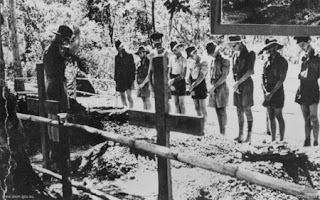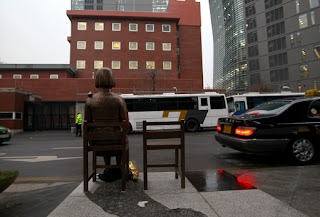In world war 2, the largest number interned by the Japanese were of Western civilians from Dutch ancestry:people who had invested in and cultivated lands of the East Indies, as far back as 300 years. The Japanese and Indonesians did not see this as investments. They saw this as exploitation, and now came their chance to strike back at the colonials. Over 110,000 Dutch men, women and children were thrown into jails, and jungle camps.Men were moved to more remote locations and were used for slave labor, for three-and-a-half years.
 |
| Last letter my mother ever received from her husband.This card came from Camp Tangsi. I found this card among her possessions when she passed away in 2003 |
Over 37.000 Dutch soldiers and militia volunteers, some as young as 15, became military prisoners of war. Of these 37,000 men, 8,500 died in Japanese custody.
Men were separated from women and children. When a boy reached the age of 10, they were taken from their mothers and placed in the mens camp. They were considered adults and a threat to the Japanese.
Can you imagine your son of 10 taken away from you, and never see him again.
Women and children were especially vulnerable to Japanese humiliation.They were captured and were marched through local villages(sometimes in a large circle, so they would pass through the same village more than once), while the Indonesians were encouraged to throw sticks and stones, and had to shout:"Last week we were your servants; this week you are our servants!" A lot of Indonesians were forced to do this, a lot of them refused, and ended in jail, just like the Dutch.
Over 300 Dutch women were forced to become military sexual slaves for the Japanese, or as the Japanese government called them,"comfort women." My mother and my aunt, my mothers sister, were one of them, which I only recently found out from the youngest sister of my mother. It makes my blood boil.
How my mother and her sister must have suffered, and how hard it must have been for them, when they arrived back in the Netherlands, total destroyed and robbed from their dignity.On top of that they had lost their husbands, they arrived in the Netherlands with only the clothes they had on their backs.Traumatized by the horror of their experience and deeply humiliated, none of the survivors spoke publicly about their experience for nearly 50 years, until in 1992 an article appeared in the Dutch Telegraaf, about the forced prostitution of Dutch women in the East Indies.
Every little excuse the Japanese camp commanders used to torment and humiliate their female captives. They were beaten in front of their children if they failed to bow properly. Bowing had to be done precisely. They had to face in the direction of Japan to the emperor Hirohito. No matter how good their behavior was, some women would be picked out, and were beaten as a "example" to the others. These Japanese had mean streaks and they seemed to enjoy themselves immensely.My mother never spoke about her wartime internment.
Mothers starved themselves to death , so their children could eat., whatever their was to eat.My mother and I with her sister and her two children spent three and half years in a former nunnery school Xavier College in Moentilan. This college was crammed with 51.500 children and their mothers, meant to hold 5000 student. On August 1, 1945 my mother and I were transported as cattle by train to another camp, Banjoebiroe 10, were we finally were rescued two month after the war had ended.
More and more about Japan's World War 2 atrocities come to light.Many victims have broken their longtime silence.A daughter told that her mother in postwar years recalled visits by Japanese doctors, who researched medical experimentation, how their children were doing, after deliberately withholding vitamins, sugar and salt from the food supply. Over 23,000 Dutch citizens died in Japanese captivity, many of them children-over three times as many as those died under the Nazi occupation of Holland.
After the war these women were trying to return to their homes in Java and other parts of Indonesia had to flee for their lives again. One recalls a 14 year-old boy who found his way home to Batavia after he had spent three-and-a-half years in a men's detention camp.The boy was so overjoyed to see his house still standing ,that he ran to his room, found a few coins in the back of a drawer, and raced out to buy candy at the local store. He was shot dead in the street by a local Indonesian militiaman.Dutch families had to be rescued and sent to the Netherlands, leaving behind all their property and possessions.
I read this in an article from JPRI at the University of San Francisco for the Pacific Rim.
Dutch foreign minister Dirk Stikker (1887-1979) , refused to waive the rights of his country's citizens to make claims against the Japanese government, as the American framers of the 1951 Peace Treaty were urging him to do.His people had suffered too much loss of life property under Japanese rule, he said, for him to consider such a waiver.The Treaty made no provision for civilian claims, and Stikker was adamant in his refusal to sign it on behalf of his government. On the date of September 8, 1951, the signing of the Peace Treaty, Stikker was still the "stubborn Dutchman." A last minute agreement that morning was persuaded to Japan's Prime Minister Shigeru Yoshida by the treaty's architect, John Foster Dulles, to agree in writing that"The Government of Japan does not consider that the Government of The Netherlands by signing the Treaty has itself expropriated the private claims of its nationals so that, as a consequence thereof, after the Treaty comes into force these claims wound be non-existent"- thus paving the way for the Netherlands to reach a cash settlement with Japan compensating former Dutch residents of the East Indies.
But it is unbelievable how arrogant the Japanese has become in their approach to implementing the agreement.
Its no wonder, then, that resentment still smolders among survivors of Japanese internment, who consistently refer to their former captors as "the Japs," and nobody is going to tell them this is not politically correct.
In an article which appeared on September 4,2001,in the New York Times, Steven Clemonts, executive vice president of the New American Foundation, revealed that a secret agreement was made between Japan and the Netherlands; explicitly not waiving individual rights of Dutch citizens to make claims against Japan, which boosted the spirits of POWs.Under the peace treaty, any benefit granted to one signatory is automatically extended to all. Thus the American POWs came to the seminar full of anticipation that the panel would engage in a serious discussion of their cases.However, Professor Vogel contrived to run out of time before such a discussion could take place. It seemed to some listeners that the panel could have addressed at least some of the important issues relating to the POW lawsuit had he not first spent time on questions such as,"What about the claims of African Americans for slavery or those of Native Americans?" It struck this listener as unconscionable that he picked these questions first over the ones posed by the actual victims of Japan's wartime conduct who, in spite of their advanced age, had traveled long distances to participate in the event.
Foreign Minister Tanaka's apology to former POWs offered during the Peace Treaty anniversary ceremony was a first step in the right direction toward resolving the issue without endless litigation. The U.S government could also play a facilitating role, as it did in the German and Swiss litigation. Congressman Rohrabacher said when he was interviewed ,"We should close the book. We are in a whole new era. Let's make sure that the last of the irritants between our countries from World War II are gone."
In the end, Congressman Rohrabacher's passionate plea for support for"the greatest heroes of American history, who were betrayed by their own government during World War II" won the day and the amendment was adopted overwhelmingly with 395 votes (33 opposing). This was in the Senate on September 11. As of October, 2001, this amendment is in a conference committee that will decide whether or not it will remain in the Commerce, Justice, State Appropriations Bill when it comes law.
On the 50 th anniversary of the signing of the Peace Treaty, hundreds of demonstrators gathered in San Francisco at the War Memorial Opera House, and shouted from across the street,"We want justice! We want justice! Will that message reach those who are in a position to resolve this issue?
More historical records will be opened and more people will learn about their story. The numbers of former POWs who were forced to work for Japanese companies are dwindling.
Prisoners of War sacrificed by 1951 peace treaty with Japan.
They fought for their country and died for their country.After the war they fought a fight to fit into society.They were send to war as young boys and suffered atrocities inflicted by other human beings, from which they will only be released when they meet their final Maker.
A section I read: Guilding the Lily: The Japanese looting.
Read the book: The Yamato Dynasty.
The secret History of Japan's Imperial Family.
by Sterling Seagrave.
Japan recovered very quickly after the war. It took them 8 months.In the last year of the war, Japan also hid large quantities of bullion at sea, deliberately sinking their ships including the cruiser Machii, sunk with all crew members in Manilla Bay, by a Japanese submarine that then machine-gunned all the Japanese crew members who came to the surface. The gold on board the Machii was recovered from its hull in the late 1970s, by President Marcos. The Japanese sub1-52, a cargo vessel the length of a football field was attempting to deliver two tons of gold worth $25 million to the Nazi submarine base at Lorient, France, when it was sunk in mid-Atlantic by a U.S Navy plane. It now has been located and recovery operation is under way. Other bulletin shipment were made by submarines to Europe and South America, and deposited in overseas branches of Swiss banks.
Japan still has not recognized that the Japanese military violated the Convention on Human Rights, purposeful and deliberately to liquidate all Dutch Nationality in and outside the concentration camps.
War is baying
"Victory-! Hail the winner!
Fail the loser!
Pitiful; there are no winners, only sinners!
War is shame with Man to blame
Shame on you! Shame on Man!
Damn your bomb and battle plan!
Deny the fight! Befriend the foe!
No wait!
For if they do,
then Man must go!
Unknown.
Lest we forget!


















































